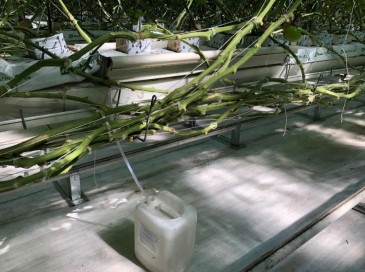Plants need water and fertilizer to grow. In the hi-tech glasshouse industry, growers apply both at the same time. A fertilizer injection system provides the fertilizer, and the drip irrigation system distributes the water evenly to the plants. How hard can it be? When Godfrey Dol, he is writing the series below about irrigation, was a student studying chemistry, he was never interested in agriculture. You plant a seed, add water, fertilizer, sunshine, and a little while later, you harvest. How hard can this be? A lot harder than he could have ever imagined.
Overwatering
So it is with irrigation, Godfrey continues. When I was about 18, my sister always asked me to look after her house plants when she went on holiday. She commented that the plants always looked healthier after I looked after them. Little did she know that I would forget to water them. By not watering them, I inadvertently strengthened the root system, whereas my sisters' love for her plants made her water them almost every day.
My sister is not the only one overwatering plants. Most people who love plants feel like they want to do something for them. The obvious thing is to give them water. In our instinctive minds, we like food, and we want to spoil our plants by giving them plenty of what we would like ourselves. We give them water, more and more, not realizing that giving too much water is bad for plants. Farmers also like to be on the safe side—the first thing they do when plants wilt is to trigger another irrigation.
In a glasshouse, wilting is usually not from a lack of water, but from a poor root system. How can we optimize the root system to have the plants perform optimally? How can we keep them healthy with minimal use of chemicals?
The roots of a plant are like the muscles in a marathon runner. There are times when we need to stress them, and times that we need to nurture them—choosing what to do when is a far greater challenge than looking after my sisters' house plants.
What do we measure?
To irrigate properly, we need to know what information we can use to improve our strategy. The first thing we want to know is the EC and pH of the drip and drain. For tomatoes, the drip EC should be 3.0. Since the plants use more water than fertilizer, the salt content in the growing medium must be about 1.5 times higher than the drip EC, in this case, 4.5. A lower EC reduces the quality of the fruit (softness and low brix), while a high EC results in less growth and smaller fruit. The pH is important because, at low and high pH, some chemicals are not water-soluble and thus become unavailable to the plant. The optimum range in the growing medium is pH=5.5-6.0. Due to root activity, the pH in the growing medium can easily rise above 6.0. In that case, the drip solution can be adjusted to as low as 5.0. Lower is not advisable, especially when Rockwool is used as low pH can dissolve the fibers. Measuring the drain percentage is also important, but not critical, as we will find out later.
So far, it is pretty straightforward. But how do we keep plant lovers from over-irrigating their glasshouse crops? Or people like me, underwatering my sisters' plants. Enter the dry-down. The drydown is the difference in the moisture content of the growing media between the maximum and minimum of a 24-hour period. The peak is usually achieved mid-afternoon, while the minimum is achieved just before the first irrigation in the morning. Using this information, we can create some irrigation guidelines. How do we know when to start and stop the irrigation, and how much water do we give in total.
The tools we need
There are some basic tools that we need to collect the right information. A scale or moisture content sensor is a very useful tool. If they are not available, a manual drain station such as pictured below is a must. Even if a scale or moisture sensor is available, a manual drain station is still recommended. Use at least one slab and collect all the days drain water in a bottle or bucket. A pH and EC meter are used to measure EC and pH, while a measuring flask can measure volume to 100 ml accuracy. Be sure also to measure the volume irrigated per dripper. It is a good check to know if the volume of irrigation water calculated by the climate computer is the same as the measured dripper volume. It also allows for the calculation of the drain percentage, by dividing the drain volume by the dripper volume.
 Figure 1; Manual Drain Station
Figure 1; Manual Drain Station
The key components we want to measure are the %dry-down, the EC in the drain, and the timing of the first drain. These three variables tell us most of what we need to know to create the right irrigation strategy. The percentage dry-down tells us if we are steering the plant into a vegetative or generative direction. The EC of the drain indicates whether we give the right amount of water. The timing of the first drain tells us if we have the growing medium hydrated enough so the plant can transpire at a maximum rate.
Is the measurement representative?
In the glasshouse industry we increasingly make use of sensors. These sensors must be representative of the rest of the irrigation zone. In the case of irrigation, one can question whether measuring one slab can represent 10,000 other slabs.
Statistically speaking the answer is no. It’s like picking a blue colored marble out of a bag with 10,000 differently coloured marbles, the chances are low. But if the irrigation zone is planted with the same variety and the distribution of temperature, humidity, light and CO2 is even, then it is like making all the other marbles light blue or dark blue and all of a sudden your chances of pulling out a blue marble is far greater.
It is surprising how a small sample can still be representative of the glasshouse. But only if the above parameters are even. More measurements are always better and therefore I prefer to back up a moisture sensor or scale with a manual drain station. If the two measuring systems show a difference, the grower can perform manual EC measurements of the surrounding growing media to verify that the single points of measurement are valid representations of the irrigation zone.
It is also important to make sure that the growing media contain a representative number of plants. When the planting density is changed, it can happen that the measured slab does not have the right amount of plants.
Equally important is that any equipment that is used is maintained to a proper standard. It includes the EC and pH meter.
This mini-series of three parts about irrigation-strategy in semi-closed glasshouses will continue with discussing how to manage the irrigation and what strategies to use for different stages of the crop.
While the irrigation strategy in a semi-closed glasshouse doesn’t differ from a conventional glasshouse, Godfrey hopes that this series clarifies in relative simple terms what is important in determining the right irrigation strategy. The strategy described in this series was the strategy used by the Automatoes Team, who won the Autonomous Greenhouse Challenge this year with the lowest water and fertiliser use.
For more information:
Glasshouse Consultancy
www.glasshouse-consultancy.com
Godfrey Dol
LinkedIn
godfrey@glasshouse-consultancy.com
+81 80 700 94 006
